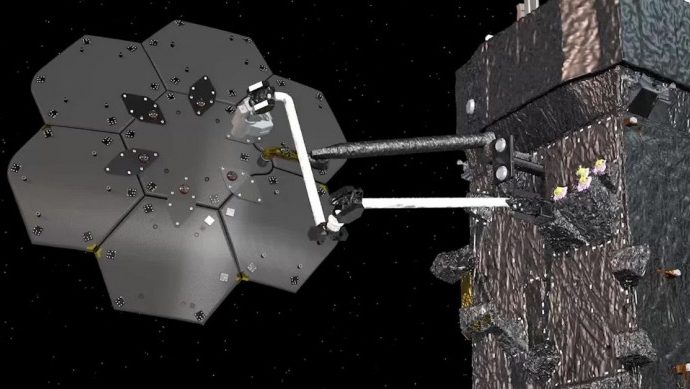NASA has contracted several companies to test a satellite-building robot in space.
Source: Interesting Engineering
The most expensive part of space exploration is lifting material into space. The Saturn V rocket of NASA’s Apollo program didn’t burn millions of liters of explosive chemicals just to put on a show; it simply takes that much propellent to generate the energy necessary to lift rockets and their pricey payloads into space. Let’s not even mention the fuel itself. No matter how you cut it, gravity is an expensive obstacle that puts a cap on the ambition of space exploration — one that NASA and SpaceX have learned the hard way. But with a new $142-million contract awarded to Maxar Technologies of Westminster, Colorado, NASA has officially launched plans to shift its strategy. Instead of building on the ground, and launching material into space — NASA is skipping the hurdle, and building spacecraft in orbit.
NASA and Maxar’s SPIDER has seven joints
Maxar Technologies is contracted to assemble both a communications antenna and a spacecraft beam, in orbit. This will happen on NASA’s Restore-L, a spacecraft designed to maintain and refuel satellites in low-Earth orbit.
Restore-L will carry Maxar’s unique payload, called Space Infrastructure Dexterous Robot (SPIDER), into orbit. The robot has a lightweight 5-meter (16-foot) robotic arm with seven joints that unfolds like a Swiss Army knife. In orbit, SPIDER will detach seven panels from Restore-L, and then connect them together — like sections of a caterpillar — to assemble a functional 3-meter (9-foot) reflector antenna, similar to the the ones used to transmit TV channels. Once it’s finished, the robotically-crafted antenna will perform Ka-band (microwave) transmissions with a ground station.
SPIDER will also build a 10-meter (32-foot) lightweight composite beam, making use of cutting-edge tech developed by Tethers Unlimited Bothell, based in Washington. This phase of the demonstration will prove the capability of SPIDER to construct large structures — like other spacecraft — in orbit.
Visionary Collaboration and Launch Estimate
“In-space assembly and manufacturing will allow for greater mission flexibility, adaptability, and resilience, which will be key to NASA’s Moon to Mars exploration approach,” said Brent Robertson, project manager of Restore-L at NASA’s Goddard Space Flight Center in Greenbelt, Maryland. As a project, Restore-L will develop a suite of technologies capable of maintaining and refueling satellites in space. At present the mission is scheduled for a mid-2020s launch date.
In addition to Maxar and Tethers Unlimited, the SPIDER payload team includes West Virginia Robotic Technology Center in Morgantown, and NASA’s Langley Research Center in Hampton, Virgina.
As the straggling leader of the world in space exploration, NASA is set to finally make good on its twentieth-century aspirations to move civilization to space. And, as the saying goes, the best is yet to come.
Source: Interesting Engineering

































Leave a Comment
You must be logged in to post a comment.